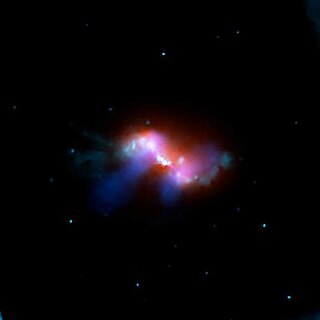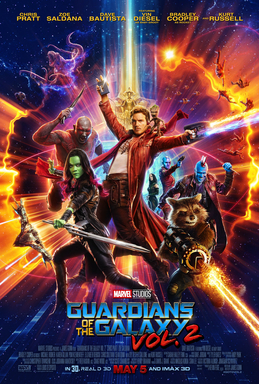Related Research Articles

A galaxy is a system of stars, stellar remnants, interstellar gas, dust, and dark matter bound together by gravity. The word is derived from the Greek galaxias (γαλαξίας), literally 'milky', a reference to the Milky Way galaxy that contains the Solar System. Galaxies, averaging an estimated 100 million stars, range in size from dwarfs with less than a hundred million stars, to the largest galaxies known – supergiants with one hundred trillion stars, each orbiting its galaxy's center of mass. Most of the mass in a typical galaxy is in the form of dark matter, with only a few percent of that mass visible in the form of stars and nebulae. Supermassive black holes are a common feature at the centres of galaxies.
A faint blue galaxy (FBG) is an inconspicuous, often small galaxy with low surface luminosity. In addition to being dim, they show a remarkable preponderance of sparsely scattered, blue stars, but comparatively few red stars, which in most galaxies are by far the most common. They appear as dim, bluish smudges on old photographic plates, with no clear structure or shape, and do not register well on modern electronic cameras, which are more sensitive to red.

The Milky Way is the galaxy that includes the Solar System, with the name describing the galaxy's appearance from Earth: a hazy band of light seen in the night sky formed from stars that cannot be individually distinguished by the naked eye. The term Milky Way is a translation of the Latin via lactea, from the Greek γαλακτικὸς κύκλος, meaning "milky circle". From Earth, the Milky Way appears as a band because its disk-shaped structure is viewed from within. Galileo Galilei first resolved the band of light into individual stars with his telescope in 1610. Until the early 1920s, most astronomers thought that the Milky Way contained all the stars in the Universe. Following the 1920 Great Debate between the astronomers Harlow Shapley and Heber Doust Curtis, observations by Edwin Hubble showed that the Milky Way is just one of many galaxies.

3C 305 is a Seyfert 2 radio galaxy located in the constellation Draco.
3C 215 is a Seyfert galaxy/Quasar located in the constellation Cancer.
3C 219 is a Seyfert galaxy with a quasar-like appearance located in the constellation Ursa Major. This galaxy's radio jets are not detectable between the core and the outer radio lobes.
3C 299 is a radio galaxy/quasar located in the constellation Boötes.
3C 303 is a Seyfert galaxy with a quasar-like appearance located in the constellation Boötes.
3C 319 is a radio galaxy located in the constellation Draco.
3C 438 is a Seyfert galaxy located in the constellation Cygnus.

Knowledge of the location of Earth has been shaped by 400 years of telescopic observations, and has expanded radically since the start of the 20th century. Initially, Earth was believed to be the center of the Universe, which consisted only of those planets visible with the naked eye and an outlying sphere of fixed stars. After the acceptance of the heliocentric model in the 17th century, observations by William Herschel and others showed that the Sun lay within a vast, disc-shaped galaxy of stars. By the 20th century, observations of spiral nebulae revealed that the Milky Way galaxy was one of billions in an expanding universe, grouped into clusters and superclusters. By the end of the 20th century, the overall structure of the visible universe was becoming clearer, with superclusters forming into a vast web of filaments and voids. Superclusters, filaments and voids are the largest coherent structures in the Universe that we can observe. At still larger scales the Universe becomes homogeneous, meaning that all its parts have on average the same density, composition and structure.

Samsung Galaxy is a series of computing and mobile computing devices that are designed, manufactured and marketed by Samsung Electronics. The product line includes the Samsung Galaxy S series of high-end smartphones, the Samsung Galaxy Tab series of tablets, the Samsung Galaxy Note series of tablets and phablets with the added functionality of a stylus, the foldable Samsung Galaxy Z series, and smartwatches including the first version of the Samsung Galaxy Gear, with later versions dropping the Galaxy branding, until the release of the Samsung Galaxy Watch in 2018.

An intergalactic star, also known as an intracluster star or a rogue star, is a star not gravitationally bound to any galaxy. Although a source of much discussion in the scientific community during the late 1990s, intergalactic stars are now generally thought to have originated in galaxies, like other stars, before being expelled as the result of either galaxies colliding or of a multiple-star system traveling too close to a supermassive black hole, which are found at the center of many galaxies.

Guardians of the Galaxy Vol. 2 is a 2017 American superhero film based on the Marvel Comics superhero team Guardians of the Galaxy, produced by Marvel Studios and distributed by Walt Disney Studios Motion Pictures. It is the sequel to Guardians of the Galaxy (2014) and the 15th film in the Marvel Cinematic Universe (MCU). Written and directed by James Gunn, the film stars an ensemble cast featuring Chris Pratt, Zoe Saldaña, Dave Bautista, Vin Diesel, Bradley Cooper, Michael Rooker, Karen Gillan, Pom Klementieff, Sylvester Stallone, and Kurt Russell. In the film, the Guardians travel throughout the cosmos as they help Peter Quill learn more about his mysterious parentage.

Marvel's Guardians of the Galaxy is an American animated television series based on the Marvel Comics superhero team of the same name. It is produced by Marvel Animation. The series airs on Disney XD. It premiered on September 5, 2015, as part of the Marvel Universe on Disney XD.

NGC 2613 is a spiral galaxy in the southern constellation of Pyxis, next to the western constellation border with Puppis. It was discovered by the German-born astronomer William Herschel on November 20, 1784. With an apparent visual magnitude of 10.5, the galaxy is faintly visible using a telescope with a 100 mm (4 in) aperture. It appears spindle-shaped as it is almost edge-on to observers on Earth.

NGC 4293 is a lenticular galaxy in the northern constellation of Coma Berenices. It was discovered by English astronomer William Herschel on March 14, 1784, who described it as "large, extended, resolvable, 6 or 7′ long". This galaxy is positioned to the north-northwest of the star 11 Comae Berenices and is a member of the Virgo Cluster of galaxies. It is assumed to lie at the same distance as the Virgo Cluster itself: around 54 million light years away. The galaxy spans an apparent area of 5.3 × 3.1 arc minutes.
Guardians of the Galaxy Vol. 2: Awesome Mix Vol. 2 is the soundtrack album for the Marvel Studios film Guardians of the Galaxy Vol. 2. Featuring the songs present on Peter Quill's mixtape in the film, the album was released by Hollywood Records on April 21, 2017. A separate film score album, Guardians of the Galaxy Vol. 2 , composed by Tyler Bates, was also released by Hollywood Records on the same date. Awesome Mix Vol. 2 was the United States' eighth best-selling album of 2017 with 600,000 copies.

NGC 708 is an elliptical galaxy located 240 million light-years away in the constellation Andromeda and was discovered by astronomer William Herschel on September 21, 1786. It is classified as a cD galaxy and is the brightest member of Abell 262. NGC 708 is a weak FR I radio galaxy and is also classified as a type 2 Seyfert galaxy.
References
- 1 2 3 4 5 "Query : 3C 268.3". Simbad. Centre de Données astronomiques de Strasbourg . Retrieved 2 June 2015.
- 1 2 3 "NED results for object 3C 268.3". NASA/IPAC Extragalactic Database. Retrieved 2 June 2015.